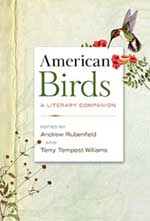
American Birds: A Literary Companion
Edited by Andrew Rubenfeld and Terry Tempest Williams
Library of America, 2020
Published by the Library of America, American Birds: A Literary Companion presents a fascinating and rich selection of writing inspired by personal encounters with birds. From Native American songs to the contemporary obsession with Big Year birding, its 250 or so pages sparkle with accounts from titans of American ornithology and doyens of American literature.
The companion’s horizon is broad—with diversity in the chronological extent of the work, the breadth of species featured, and the context in which they are written about. The result is a dynamic pace, moving between longer reflections and shorter poems without ever jarring.
The book opens with a foreword from Terry Tempest Williams and an introduction by Andrew Rubenfeld. Of the two, it is Rubenfeld’s that establishes the most personal connection to the endeavor. From the efforts of his first day of birding to a careful mapping out of the literary landscape of each period covered, Rubenfeld’s comprehensive statement is required reading as prelude to what follows. He provides the connective tissue for what is, of necessity, a varied assemblage.
Tackling American Birds from start to finish on first reading brings great reward. Of course, it is perfectly suited to dip in and out of—to inspire efforts on a crisp spring morning in Central Park, or in advance of a trek in the High Sierras. But to follow the book’s chronological path at least once is to better appreciate changing styles of writing, and shifts in the prevailing concerns of those who have felt compelled to record both the wonder and the malaise of the American environment as charted by its birds.
We walk alongside Meriwether Lewis and William Clark as they journey west, and search for birds and flowers with Emerson and Thoreau near Walden Pond. We read Audubon’s detailed description of the behavior of the Ivory-billed Woodpecker, ending on the rather macabre observation that the bird’s claws “remain cramped to the spot for several hours after death.” And there is the magic of Walt Whitman’s “Birds Migrating at Midnight,” describing something that we all might know is happening but would struggle to describe with such facility and clarity.
A by-product of any well-set anthology are the discoveries and new connections it can inspire. In particular, reading of the “warped night air” in Richard Wilbur’s “Barred Owl” from 2000 reminded me of the equally dark memory described in George Cary Eggleston’s “Midnight” from 1874—both poems managing to balance the winsome with the terrifying.
In this, and other ways, American Birds truly helps to establish an entirely new perspective on my fascination with birds and the environment we share with them. I found myself looking back on particular species in a new light, and recalling some of the wilder Californian landscapes I had the good fortune to walk with a greater sense of connection, respect, and—dare I say—fondness. Indeed after my own first reading, I was left in a state similar to that described by John Haines in the closing lines of “If the Owl Calls Again”: “And when the morning climbs / the limbs / we’ll part without a sound, / fulfilled, floating / homeward as / the cold world awakens.”
There is just one break with the book’s chronological protocol. W. S. Merwin’s “Unknown Bird” of 2001—though technically preceding Noah Strycker’s efforts in unpicking the vagaries of American airline scheduling—appears last. The positioning is far from accidental. In the closing piece, Merwin describes the single “fluted phrase” that is gone as suddenly as it appears. It perfectly describes what ought to be the true joy of birding—that all is not knowable—that the heard but unseen can be as rewarding as the photographed and assigned. Accepting the possibility of the unsolved ornithological mystery is key to the joy of birding, driving our determination to discover, and our joy in doing so.
The book too is a joy—an escape on a wet weekend upstate, respite on a long flight overseas, or as a prompt to the greater riches of American environmental writing—of which this book is but a snapshot. It is also a reminder of the existential crisis we find ourselves in. And it is because of this that American Birds should be required reading for many different audiences. For birders, it’s a fascinating glimpse into the history of their pursuit, charted by its pioneers. For historians, it follows the ebb and flow of American history, charted by some of the nation’s most unexpected and unsung heroes. And for us all, it offers salutary lessons through journal, poetry, and prose of the importance of protecting our fragile earth.

